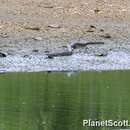en
names in breadcrumbs


Homalopsid snakes are collectively called mud snakes or Oriental-Australasian rear-fanged water snakes. The largest species reach body lengths of 1.3 meters, and some species are dwarfs, rarely exceeding 400 mm. Homalopsids range from Pakistan's Indus River Delta eastward across tropical Asia to the Philippines, southward into Indonesia, Australia and New Guinea, and a single species is known from Micronesia. While most have semi-aquatic or aquatic life styles, a few are more terrestrial. The semi-aquatic and aquatic species tend to feed on crustaceans and fish, more terrestrial species feed on frogs and worms. They seem to form two major groups, the basal group tends to be terrestrial and fangless, the more aquatic group tends to have rear-fangs on the maxillary bone and venom glands. All are viviparous, and have nasal valves. Some of the aquatic species are restricted to freshwater, while others exploit coastal environments with a tolerance to salinity.
The family Homalopsidae was long considered a subfamily (the Homalopsinae) of the family Colubridae. However, while the homalopsids are colubroid snakes, they are not members of the family Colubridae. Homalopsidae is a clade of snakes composed of morphologically and ecologically diverse species sharing grooved rear-fangs, crescent-shaped, valvular nares, small eyes, a tracheal lung, and hypapophyses throughout the vertebral column. Gyi (1970) produced the first modern taxonomic treatment of the group (he recognized the Homalopsinae, a subfamily of the Colubridae). Based on classical morphological criteria (scale counts, body size measurements, and notes on color pattern of 1,038 specimens), Gyi recognized 10 genera and 34 species.Recent molecular phylogenetic analyses have elevated the clade from subfamilial to familial status (Lawson et al. 2005), supported the hypothesis that it is monophyletic (e.g., Voris et al. 2002; Alfaro et al. 2008), and robustly recover the Homalopsidae as the sister group to colubroids and elapoids sensu Vidal et al. 2007 (Vidal & Hedges 2005, 2009; Kelly et al. 2003; Vidal et al. 2007; Weins 2008). Vidal et al. (2007) suggest the Homalopsidae be placed in the superfamily Homalopsoidea. These recent analyses suggest that the homalopsids are a clade of early Miocene origin that exhibits considerable morphological and ecological diversity (Alfaro et al. 2008). Recently, Murphy (2007) has updated and expanded Gyi’s (1970) monograph (recognizing 10 genera and 37 species) and summarized the available morphological, ecological, and biogeographic information on each species.
Twenty-two of Gyi's species were in the genusEnhydris, a genus based on the presenece of smooth dorsal scales and the nasal scales that were in contact. Molecular studies suggestedEnhydriswas infact polyphyletic (Voris et al. 2002; Alfaro et al. 2008).
McDowell (1987) suggested thatBrachyorrhosKuhl in Schlegel be added to the family despite the absence of rear-fangs and a terrestrial lifestyle. Murphy (2007) initially skeptical of the placement of Brachyorrhoswithin the Homalopsidae, but molecular evidence supported the relationship ofBrachyorrhoswith the Homalopsidae species (Murphy et al., 2011). Thus, despite its terrestrial lifestyle, fangless maxillary bone, and vermivorous diet,Brachyorrhosis an early divergent lineage within the Homalopsidae. On-going investigations into homalopsid snakes suggest the family contains more species and genera than originally thought. Murphy (2011) revalidated the genusPseudoferraniaforEnhydris polylepis, and established the genusDjokoiskandarusforCantoria annulata. Kumar et al. (2012) revalidated the genusFerraniaforEnydris seiboldi, andDieurostusforEnhydris dussumierii.Additionally, Murphy et al. (2012) established the genusMyrrophisforEnhydris chinensisandE. bennettii. Murphy et al. revalidatedCalamophisMeyer based onBrachyorrhos jobiensisand three previously undescribed species.
The Homalopsidae therefore contains the terrestrial/fossorialBrachyorrhos; the semi-terrestrial fish and frog-eatingEnhydris plumbea; highly aquatic, active foraging freshwater, fish-eating-species Enhydris enhydris andE. subtaeniata; the completely aquatic, freshwater ambush specialistErpeton tentaculatus; the terrestrial-brackish water, fish-eatingMyrrophis bennettii; as well as the brackish water and marine species that occasionally enter freshwater, and feed on fish, crustaceans, and gastropods (Cantoria,Cerberus,Fordonia,Gerarda,Myron). Homalopsids have adapted to an extremely broad range of terrestrial and aquatic lifestyles and diets (Murphy, 2007).